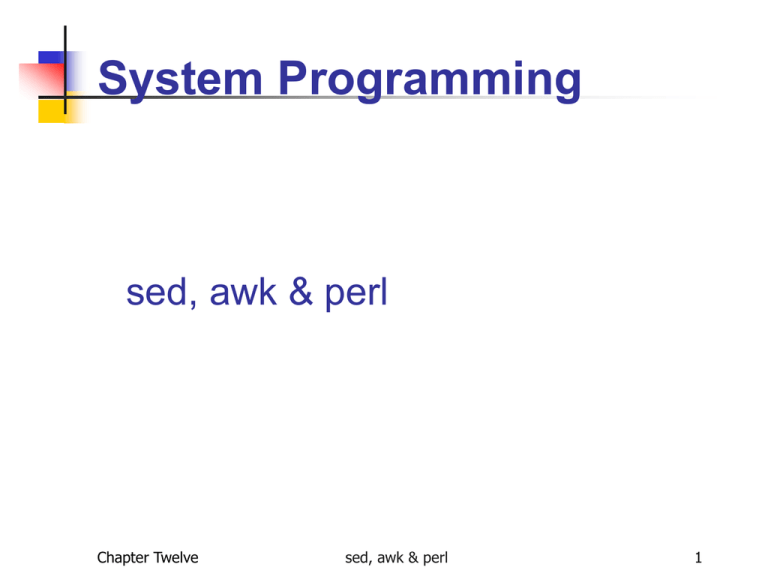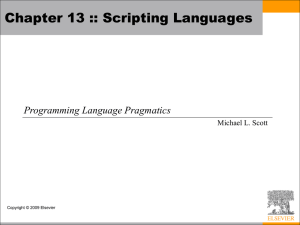Chapter12
advertisement

System Programming
sed, awk & perl
Chapter Twelve
sed, awk & perl
1
sed
Stream editor
Originally derived from “ed line editor”
Used primarily for non interactive
operations
operates on data streams, hence its name
Usage:
sed options ‘address action’
file(s)
Example: sed ‘1$ s/^ bold/BOLD/g’ foo
Chapter Twelve
sed, awk & perl
2
sed:Line Addressing
using line numbers (like 1,3p)
sed ‘3,4p’ foo.txt
sed ‘4q’ foo.txt
“For each line, if that line is the third through
fourth line, print the line”
“For each line, if that line is the fourth line,
stop”
sed –n `3,4p’ foo.txt
Since sed prints each line anyway, if we only
want lines 3&4 (instead of all lines with lines
3&4 duplicated) we use the -n
Chapter Twelve
sed, awk & perl
3
sed:Line addressing (...continued)
sed –n ‘$p’ foo.txt
“For each line, if that line is the last line, print”
$ represent the last line
Reversing line criteria (!)
sed –n ‘3,$!p’ foo.txt
“For each line, if that line is the third through
last line, do not print it, else print”
Chapter Twelve
sed, awk & perl
4
sed:Context Addressing
Use patterns/regular expressions rather
than explicitly specifying line numbers
sed –n ‘/^ From: /p’ $HOME/mbox
retrieve all the sender lines from the mailbox
file
“For each line, if that line starts with ‘From’,
print it.” Note that the / / mark the beginning
and end of the pattern to match
ls –l | sed –n ‘/^.....w/p’
“For each line, if the sixth character is a W,
print”
Chapter Twelve
sed, awk & perl
5
sed:Substitution
Strongest feature of sed
Syntax is
[address]
s/expression1/string2/flag
sed ‘s/|/:/’data.txt
substitute
substitute the character ‘|’ with the character
‘:’
sed ‘s/|/:/g’ data.txt
global
Chapter Twelve
sed, awk & perl
6
sed:Using files
Tedious to type in commands at the
prompt, especially if commands are
repetitive
Can put commands in a file and sed can
use them
sed –f cmds.sed data.txt
File with commands
Chapter Twelve
sed, awk & perl
7
awk
Powerful pattern scanning and processing
language
Names after its creators Aho, Weinberger
and Kernighan (Don’t you love how
commands are named?)
Most commands operate on entire line
awk operates on fields within each line
Usage:
awk options [scriptfile] file(s)
Example: awk –f awk.script foo.txt
Chapter Twelve
sed, awk & perl
8
awk: Processing model
BEGIN { command executed before any
input is
read}
{
Main input loop for each line of input
}
END {commands executed after all
input is
read}
Chapter Twelve
sed, awk & perl
9
awk: First example
# Begin Processing
BEGIN {print "Print Totals"}
# Body Processing
{total = $1 + $2 + $3}
{print $1 " + " $2 " + " $3 " = "total}
# End Processing
END {print "End Totals"}
Chapter Twelve
sed, awk & perl
10
Input and output files
Input
22 78 44
66 31 70
52 30 44
88 31 66
Chapter Twelve
Output
Print Totals
22 +78 +44 =144
66 +31 +70 =167
52 +30 +44 =126
88 +31 +66 =185
End Totals
sed, awk & perl
11
awk:command line processing
1
1
1
2
2
2
2
İnput
clothing
computers
textbooks
clothing
computers
supplies
textbooks
Output
1 computers 9161
2 computers 2321
3141
9161
21312
3252
12321
2242
15462
awk ‘if ($2 =="computers“){print}'sales.dat
Chapter Twelve
sed, awk & perl
12
awk:Other features
Formatted printing using printf
Conditional statements (if-else)
Loops
for
while
do-while
Chapter Twelve
sed, awk & perl
13
awk:Associative arrays
Normal arrays use integers for their
indices
Associative arrays with strings as their
indices
Example:Age[“Robert”]=56
Chapter Twelve
sed, awk & perl
14
awk: Example
# salesDeptLoop. awk script
BEGIN {OFS = "\ t"}
{deptSales [$ 2] += $3}
END {for (item in deptSales)
{
print item, ":", deptSales[ item]
totalSales += deptSales[ item]
} # for
print "Total Sales", ":", totalSales
} # END
Chapter Twelve
sed, awk & perl
15
Input and output
1
1
1
2
2
2
2
İnput
clothing
computers
textbooks
clothing
computers
supplies
textbooks
Chapter Twelve
Output
Computers : 9161
Supplies
: 2321
Textbooks : 36774
Clothing
: 6393
Total sales: 66891
3141
9161
21312
3252
12321
2242
15462
sed, awk & perl
16
awk: Example
# salesDeptLoop. awk script
BEGIN {OFS = "\ t"}
{deptSales [$ 2] += $3}
END {for (item in deptSales)
{
print item, ":", deptSales[ item]
totalSales += deptSales[ item]
} # for
print "Total Sales", ":", totalSales
} # END
Chapter Twelve
sed, awk & perl
17
Perl
"Practical Extraction and Reporting
Language"
written by Larry Wall and first released in
1987
rumour: name came first, then the
acronym
"Perl is a language for easily manipulating
text, files and processes": originally aimed
at systems administrators and developers
Chapter Twelve
sed, awk & perl
18
Features
enables quick development of programs
no need to define variable types
portable
extensible (module import/export mechanism)
powerful "regular expression“ capabilities
simple I/O model
many modules
support for static scoping
built-in debugger
Chapter Twelve
sed, awk & perl
19
Common uses
text-stream filters
transforming,stripping,annotating, combining
simple text manipulation
Common Gateway Interface (CGI) scripts
report generation
system scripting
general solution prototyping
Hello,World!
print ("Hello,world!\n");
print "Hello,world!\n";
print STDOUT "Hello,world!\n";
Chapter Twelve
sed, awk & perl
20
Executing Perl scripts
"bang path“ convention for scripts:
can invoke Perl at the command line, or
add #!/public/bin/perl at the beginning
of the script
exact value of path depends upon your
platform (use "which perl“ to find the path)
From the command line:
%perl
print "Hello,World!\n";
CTRL-D
Hello,World!
Chapter Twelve
sed, awk & perl
21
Basics
kinds of variable:
scalars, lists, "hashes“ (also called
"associative arrays“ or "dictionaries")
some rudimentary support for objectorientation, but not really designed as
an OOP language
advanced perl supports pointers, userdefined structures, subroutine references
Chapter Twelve
sed, awk & perl
22
Basics (contd)
An example:
#!/public/bin/perl
$fruit{"apples"}=5;
$fruit{"oranges"}=3;
$fruit{"lemons"}=2;
$fruit{"limes"}=2;
@keys =keys(%fruit);
foreach $f (@keys) {
print "We have $fruit{$f} $f\n";
}
Chapter Twelve
sed, awk & perl
23
Control structures
Similar to that in C:
if () {}
if () {} else {}
if () {} elsif () {} else { }
(note spelling)
while () {}
do { } while()
for (;;) {}
foreach:iterates over each element in a list
No "switch“ statement:
must use sequence like "if-elsif-elsif-else"
conditional expressions as in C:
non-zero value:true
zero value:false
Chapter Twelve
sed, awk & perl
24
using shell commands in Perl
example:
$file_01 =“/home/foobar/ex1.txt”;
$file_02 =“/home/foobar/ex2.txt”;
…
$result =system (“diff $file_01 $file_02”);
if ($result ==0) { #files were the same
}else { #files were different}
if we are interested in only the result value and
not the output from the command, redirect output
to /dev/null
example:…
system(“diff $file_01 $file_02 >/dev/null”)
Chapter Twelve
sed, awk & perl
25







